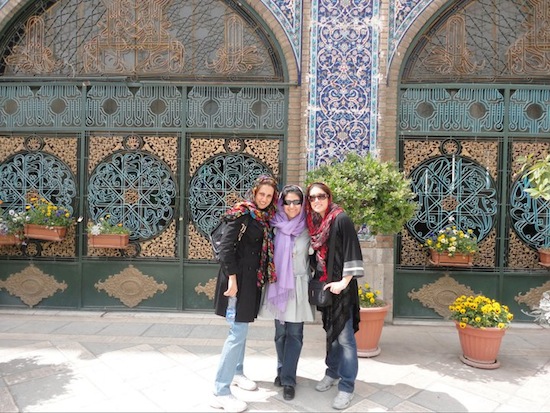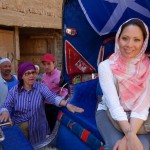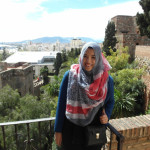Iran Travel: A Conversation with Novelist Marjan Kamali

Few American women today have the chance to venture into Iran. The media portrays Iran as a controversial and dangerous place, but the day-to-day lives of the people remain cloaked in mystery. When I read American writer Marjan Kamali’s article in the Wall Street Journal about the beauty-obsessed culture in Iran–which she discovered during her recent trip there–I knew I had to get in touch. Kamali, author of Together Tea, an award-winning novel about family and love in Iran and America, decided to travel with her family to Iran to visit friends. Though Kamali was worried about her family’s safety, she still made sure to immerse herself in the culture, which enabled her to push past her fears, cut through stereotypes and bear witness to the lives of women in Iran.
Iran Travel: A Conversation with Novelist Marjan Kamali
Coming from the US, it seems like it would be an ordeal to even be able to travel to Iran. What sort of preparations did the trip require? What did your physical travel route look like?
Marjan Kamali: Before the 1979 Islamic revolution, Iran used to be a very popular tourist destination and many Americans vacationed and lived there. Since the breakdown of relations 34 years ago, travel between the two countries has been harder. Now, U.S. citizens need to obtain a visa to travel to Iran. A valid visa can be obtained from the Iranian Interests Section at the Embassy of Pakistan in Washington, DC. To learn more about what’s required, you can visit http://daftar.org/. As with travel to any country, you should also check the U.S. travel advisory site.
When flying to Iran, most visitors from the U.S. fly to Europe and then change planes. There used to be direct flights between the two countries and there has been some talk of resuming flights if relations improve. In the meantime, visitors can switch for a direct flight to Tehran in cities such as Amsterdam, Doha, Dubai, Frankfurt, Geneva, and Istanbul.
In your article in the Wall Street Journal, you write that while you made sure to pack a very modest wardrobe and cover your hair completely, many local women in the street were not as strict. From your own experiences and your conversations with your family in Iran, what role does the morality police play in people’s everyday lives? What is the suggested dress code for women in Iran?
Since hijab laws were enacted after the 1979 revolution, women are required to cover their hair and bodies in public. However, the extent of this varies depending on each individual woman. Some religious women choose a chador, a big piece of cloth that covers the hair and body and is held by hand under the face. Other women are much more liberal in their dress and will have a very light headscarf that exposes quite a bit of hair and choose colorful tunics over jeans and sneakers. The morality police do sometimes show up, but since the inauguration of the new President, Hassan Rouhani, it has been promised that they will play a much lesser role in women’s lives in general.
Iran Travel: A Conversation with Novelist Marjan Kamali
Also in your article, you write about how Iranian women are obsessed with beauty–and in particular, facial beauty. As your cousin explains, “‘It’s the only physical part of me I can show.'” What is included in the daily/weekly beauty routine for Iranian women?
Traditionally, women in Iran have taken good care of themselves and this applies to exercise and nutrition (lots of fruits of vegetables) and a daily diet that by nature and tradition is the Mediterranean diet. They also take good care of their skin, using a traditional exfoliating wash cloth called a kisseh. Since many Iranian women have dark or thick hair, eyebrow shaping seems to be a very regular part of the beauty routine. You will see some of the world’s best groomed eyebrows in Iran! Make up is also quite popular and it is more common to see women in the big cities with make up on than to see them without it.
Many people believe that in cultures where women cover up, they can focus less on their appearances and build more confidence in their skills and who they are as people. Based on what you saw in Iran, how would you respond to this statement?
I do think there is some truth to this. One strange aspect of the hijab is that in some ways you worry less about your appearance (doesn’t matter what you’re wearing under your raincoat or tunic – just throw it on before you go outside!) But then again, there is a focus on the impression you’re making and how you look just like in any culture. Women tend to personalize their look with accessories and unique twists and make up. Each country in the Middle East has its own rules and traditions regarding women’s rights. In Iran, before the 1979 revolution, women could dress however they wanted and many women held high level professional positions. Today they continue to excel in education and achievement. In fact, women now comprise more than 60 percent of university students. What can be said for sure is that Iranian women remain ambitious, educated, and achievement-oriented with or without the hijab.
As a woman traveler in Iran, what specific challenges did you face as a woman? What cultural/societal norms did you need to adapt to?
Most travelers from the U.S. need to get used to covering their hair and body when they are outside. Also, in public transportation and in some public buildings such as mosques, genders are segregated. Public swimming is also an activity that is designated by gender with different times for men and women. But the cultural differences with the West are less in Iran than in many Middle Eastern countries. Women are educated, drive, work, and are fairly independent and outspoken. They are active, vocal members of society and have roles not that different than in the West.
Iran Travel: A Conversation with Novelist Marjan Kamali
As a mother traveling with your children in Iran, how did you prepare them for the new culture and political environment? How did they react to their experiences in Iran?
I tried explaining to them that as visitors, we needed to be respectful and open to new experiences. Before long, they were more entranced with the commonalities and less with the differences. Also, it was interesting to see them react to the real Iran as opposed to what they had seen on the TV news. On our first morning in Tehran we walked around the city and my daughter said, “I thought it would be in black and white. But it’s actually in color”.
Iran Travel: A Conversation with Novelist Marjan Kamali
In your article, a cab driver tells you, “‘In the West, where you are free, tell me, are people so vain? Of coure not! I mean, look at your bland face. It’s admirable!'” How else did people react when they learned that you were American?
Most people would exclaim how much they loved a certain American TV show or song. People in Iran listen to American music and are much more in tune with our American pop culture than you’d guess because many people have access to satellite dishes, the internet, etc. I never felt any hostility for being from America and most Americans who visit Iran would tell you the same.
What are places, if any, in Iranian society where women and men are separated?
Usually in public transportation and public buildings such as mosques. Also, in swimming areas. Sometimes at private parties or big events such as weddings and funerals, men and women separate themselves but that has less to do with laws and more to do with tradition/flow of conversation.
Iran Travel: A Conversation with Novelist Marjan Kamali
On Pink Pangea, women have shared their experiences in women-only hammams or belly dancer classes in different countries in the Middle East. What are some women-only venues in Iran that you’d recommend that other women travelers check out?
I didn’t have a chance to visit one, but I have been told about women-only swimming pools and water parks. Usually, there are separate times for men and women so women can wear bikinis and tan and such without being in the presence of men. I’d love to visit a water park to hear the gossip and be served tea by the waves.
We’d love to hear any other tips/advice you’d like to share with women planning to travel to Iran!
If you are new to Iran, going with a trusted tour company is probably your best bet as you will get the most out of your experience and you will most likely be taken not just to Tehran, but to ancient sites such as Persepolis and the famed cities of Shiraz and Isfahan. Make sure you take a big appetite – Persian food is delicious and you will be served a lot of it (more than you can eat, because your Iranian hosts will insist that no, you must eat more). Be prepared for an ancient culture with lots of modern twists and take a journal and camera with you because a lot of your impressions will surprise you.
Iran Travel: A Conversation with Novelist Marjan Kamali / Iran travel








